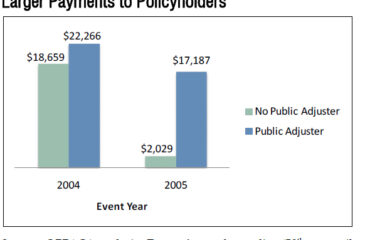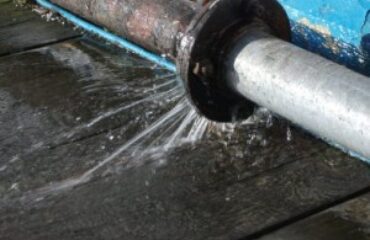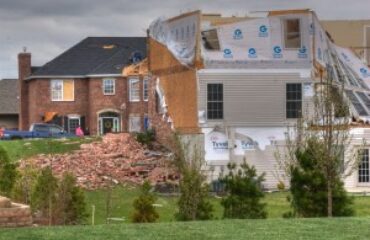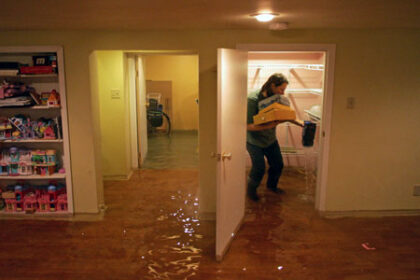
SPRINGFIELD, Ill. (AP) — Diane Hopp says she doesn’t have a green thumb, so if her neighbors were around, they might be surprised to see her spraying a garden hose — particularly in December inside the living roo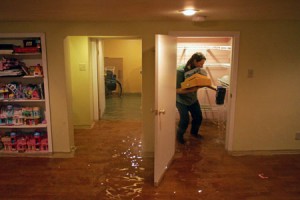 m of a newly renovated home.
m of a newly renovated home.
“It really bothers me to see all this mess, and that we did it,” she said.
The insurance agent from Petersburg, Ill., was one in a line of hose-wielders helping christen the small, frame structure on the edge of downtown Springfield — fondly nicknamed “flood house” — as part of an unusual experiment to assist the untold thousands who bemoan indoor flooding from the showers of spring and the burst pipes of winter.
The owner of the house, Peerless Cleaning and Restoration Services, says it is one of just a few “flood houses” it knows about. The company intends to flood it twice a month to help insurance agents know better what to do when a client calls, real estate agents more readily spot long-ignored problems that spawn mold, and eventually would-be technicians in learning to run vacuums and moisture meters.
The company promised that within days the custom rebuilt structure — outfitted with its own industrial strength sprinklers and spigots sticking out of the walls — would be bone-dry and ready to be doused again for the next demonstration.
Michael Barry, a spokesman for the Insurance Information Institute, said Americans generally underestimate the chances they’ll be hit by unwelcome water. He said he hadn’t heard specifically of “flood houses,” but applauded efforts to teach homeowners and agents what’s at stake.
“Any time you can expand public understanding of the risk a homeowner faces, it’s a good thing,” Barry said.
Water damage is the second-leading cause of insurance claims in Illinois, according to 2009 data from State Farm Insurance Cos. After wind and hail, water wreckage comprised the largest number of claims, averaging $7,900. Crime was third, and a different kind of water devastation — drain and sewer backups — was fourth, averaging $8,800 per claims.
Decatur, Ill.-based Peerless thinks its novel “flood house” laboratory will add depth to classes like “Hands-on Water Damage,” which they offered in December to nine insurance agents and assistants needing continuing education credits. Company officials said they know of a handful of such houses around the country and had seen a couple, but not outfitted like theirs.
When the company moved its Springfield location last summer, it bought and remodeled the house across the alley for about $90,000, adding carpeting, a restored hardwood floor and fresh paint — all ready to be drenched.
Learning what goes into drying soaked carpets, drywall with insulation behind it, and ceilings buffeted by leaking upstairs toilets — and then seeing it happen — pays dividends when that panicked call comes in from a client, said Matt Bennett, an agent from Forsyth, Ill., who attended the demonstration.
“You know what questions to ask,” Bennett said. “When the homeowner says, ‘I have a small leak,’ you know that’s how it appears, but we can take what they tell us to find out if there are hidden sources of the problem.”
After a morning learning about degrees of contaminants in water and how many dehumidifiers are necessary per cubic foot, the group assembled on the first floor of the flood house, which was bright, clean and kitchen-less. Peerless vice president Todd Garner then cranked on the first sprinkler over a glass-top table and padded chairs, onto the hardwood floor.
It sounded like rain pounding on the table. Water shooting in all directions from the sprinkler heads gave a carousel effect as Garner maneuvered levers in the wall. Nearly everyone in the room wore a sheepish smile, perhaps feeling a little sick. That’s the point.
“You have a customer who’s gone for a weekend, and a half-inch line breaks, it’s going to be whipping out a lot of water,” Garner said earnestly.
The agents took turns with the garden hose, saturating the carpet, then later returned to test water extraction methods, from the hardware-store bought wet-dry vac to a Segway-like riding machine that professionals use. The high-end model sucked nearly all the water out of not only the carpet, but the pad underneath.
“When someone calls, if you’ve never lived through a disaster, you haven’t any idea what they’re experiencing,” said Hopp, who processed claims from a deadly Petersburg tornado last New Year’s Eve. “Now we see what they’re seeing.”
[footer1]


